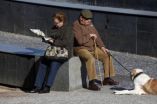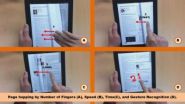(Press-News.org) January 10, 2012 (PORTLAND, Ore.) — Older women who have lost more than two inches in height face an increased risk of breaking bones and dying, according to a new study published in the January issue of the Journal of Bone and Mineral Research and funded by the National Institutes of Health.
The study found that women 65 and older who lost more than two inches over 15 years were 50 percent more likely to both fracture a bone and to die in the subsequent five years, compared to women who lost less than two inches in height.
"Most women do lose height as they age, but we found that those who lost more than two inches were at higher risk of breaking a bone and of dying," said lead author Teresa Hillier, MD, MS, an endocrinologist and senior investigator at the Kaiser Permanente Center for Health Research in Portland, Ore. "These women were at higher risk of dying from a fracture, but they were also at higher risk of dying from more common causes, including heart disease."
Height loss may be an indicator of osteoporosis, a weakening of the bone that can lead to fractures of the spine, hip, wrist and other bones. Hip fractures are the most debilitating. Nearly 300,000 people are admitted to the hospital each year with a hip fracture, according to the Centers for Disease Control and Prevention. As many as 20 percent of them will die within a year after the fracture and many others will become disabled, previous research has shown.
"We need to do everything we can to prevent these fractures and our study suggests that clinicians don't need to wait until they have two height measurements before they can be proactive," Hillier said. "Most older women remember how tall they were in their mid 20s, and if they measure two inches shorter than that, clinicians should consider bone density testing, counseling, and possible treatment to help prevent fractures."
Prior studies have reported that significant height loss puts men at higher risk for heart disease and death, but this is the first study to find an association between height loss and death in women. Another study to be published in the same issue of the Journal of Bone and Mineral Research found that men over 70 who lost two inches or more were at greater risk for fracturing a hip, compared with men who lost less height.
The main analysis for the new Kaiser Permanente study involved 3,124 women who were 65 and older during the mid-1980s, when they were recruited for the landmark Study of Osteoporotic Fractures. The study has been going on for more than two decades and includes women from Baltimore, Minneapolis, Portland, Ore., and the Monongahela Valley near Pittsburgh.
Height loss was determined by comparing height measurements taken during an initial clinic visit with measurements taken during a clinic visit 15 years later. A stadiometer was used to measure height. Spine fractures were detected through X-rays, and bone density was measured using a standard bone scan.
In addition to the clinic visits, women filled out health questionnaires every four months and were asked if they'd broken a hip or other bone. Those who didn't fill out the mailed questionnaires were contacted by phone. Public death records were used to confirm mortality.
In addition to the main analysis, researchers also conducted a sensitivity analysis among all 9,704 women in the SOF study and looked at the significance of height loss that had occurred before the women entered the study at age 65 or older. At the beginning of the study, women were asked to recall how tall they were at age 25, and that height was compared to their actual height. Researchers found that women who reported losing more than two inches in the previous 40 years were also at higher risk for fractures and death.
###
The SOF study was supported by grants from the National Institute of Arthritis and Musculoskeletal and Skin Diseases and the National Institute on Aging.
Authors include Teresa A. Hillier, MD, MS; Erin S. LeBlanc, MD, MPH and Kimberly K. Vesco, MD, MPH from the Kaiser Permanente Center for Health Research in Portland, Oregon; Li-Yung Lui, MA, MS; Douglas C. Bauer, MD; Dennis M. Black, PhD and Steven R. Cummings, MD from the California Pacific Medical Center and the University of California in San Francisco; Debra M. Kado, MD,MS from the David Geffen School of Medicine at UCLA in Los Angeles; Jane Cauley, DrPH at the University of Pittsburgh; Kristine E. Ensrud, MD, MPH from the Veterans Affairs Medical Center and Department of Medicine and Division of Epidemiology & Community Health at the University of Minnesota; and Marc C. Hochberg, MD from the University of Maryland in Baltimore.
This study is part of ongoing research and preventive work at Kaiser Permanente to understand and prevent bone fractures. Another study published by Kaiser Permanente researchers in September, 2011 in the Archives of Internal Medicine found that women ages 65-69 who break a hip are five times more likely to die within a year than women of the same age who don't break a hip.
About the Kaiser Permanente Center for Health Research (http://www.kpchr.org)
The Kaiser Permanente Center for Health Research, founded in 1964, is a nonprofit research institution dedicated to advancing knowledge to improve health. It has research sites in Portland, Honolulu, and Atlanta.
About Kaiser Permanente
Kaiser Permanente is committed to helping shape the future of health care. We are recognized as one of America's leading health care providers and not-for-profit health plans. Founded in 1945, our mission is to provide high-quality, affordable health care services and to improve the health of our members and the communities we serve. We currently serve 8.9 million members in nine states and the District of Columbia. Care for members and patients is focused on their total health and guided by their personal physicians, specialists and team of caregivers. Our expert and caring medical teams are empowered and supported by industry-leading technology advances and tools for health promotion, disease prevention, state-of-the art care delivery and world-class chronic disease management. Kaiser Permanente is dedicated to care innovations, clinical research, health education and the support of community health. For more information, go to: www.kp.org/newscenter.
END
A UC Davis graduate student who is leading a study of the collision of galaxy clusters 5 billion light years away will discuss the team's findings today, Jan. 10, in a press briefing at the annual meeting of the American Astronomical Society in Austin, Texas.
"A galaxy cluster is like a little universe, because it has the same matter composition as the whole universe," said William Dawson, a Ph.D. candidate in physics. "By studying this little universe, we can learn more about our own."
This "little universe" is formally called DLSCL J0916.2+2951 and consists of two ...
For immediate release - January 10 - (Toronto) – In a new study from the Centre for Addiction and Mental Health (CAMH), people with schizophrenia showed greater brain activity during tests that induce a brief, mild form of delusional thinking. This effect wasn't seen in a comparison group without schizophrenia.
The study appears in the December issue of Biological Psychiatry.
"We studied a type of delusion called a delusion of reference, which occurs when people feel that external stimuli such as newspaper articles or strangers' overheard conversations are about them," ...
Handball is one of the top four sports, at least as far as the risk of injury is concerned. In particular, the jump shot frequently causes sprained ankles, tears to the ligaments connecting the bones of the foot and the lower leg. One of the goals of sports science is to minimize sporting injuries while also improving performance. To this end, many trainers and sports scientists are making increasing use of hi-tech methods, such as the computer modelling of moving joints.
Virtual ankle
To understand why the ankle is so prone to injury during the jump shot, a team ...
Countless mice, rats and rabbits die every year in the name of science – and the situation is getting worse. While German laboratories used some 2.41 million animals for scientific research in 2005, by 2009 this number had grown to 2.79 million. One third were destined for fundamental biology research, and the majority were used for researching diseases and developing medical compounds and devices. People demand medicines that are safe and therapies that are tolerable, but hardly anyone is happy to accept the need for animal testing. This is why scientists have spent years ...
A group of experts has prepared a report on vitamin D supplementation for menopausal women after it was revealed that Europeans have suffered an alarming decrease in their levels of this vitamin. In their opinion, the ideal would be to maintain blood levels above 30 ng/ml. Vitamin D is essential to the immune system and processes such as calcium absorption.
"We believe that many diseases can be aggravated by a chronic deficiency of vitamin D," states Faustino R. Pérez-López, researcher at the University of Zaragoza. In particular, this is worse during the menopause as ...
Total Mortgage Services, LLC, a leading mortgage lender, announced today the hiring of Neil Bader as the Company's National Retail Sales Manager. To this important management position, Mr. Bader brings more than 25 years of production, leadership, and entrepreneurship within the mortgage industry. In his new role, Mr. Bader will be responsible for expanding Total Mortgage's successful retail channel, as it continues its nationwide growth. Mr. Bader will be based in Milford, Connecticut and report directly to John Walsh, President of Total Mortgage.
"Neil is a focused ...
Daejeon, Republic of Korea, January 10, 2012—Korea Advanced Institute of Science and Technology (KAIST) announced today that its research team headed by Professor Howon Lee from the IT Convergence Research Institute has developed a technology that will make reading on smartphones and tablet PCs easier than now.
The technology, called the "Smart E-book System," allows users of smartphones and tablet PCs to effortlessly flip through the pages of an e-book or cross-reference its contents, just as they would with paper-based books and magazines.
Unlike conventional displays ...
A new study supports previous findings that children delivered by cesarean section have an increased risk of developing asthma.
The study from the Norwegian Mother and Child Cohort Study (MoBa) suggests that children delivered by cesarean section have an increased risk of asthma at the age of three. This was particularly seen among children without a hereditary tendency to asthma and allergies.
Data from more than 37 000 participants in the MoBa study were used to study the relationship between delivery method and the development of lower respiratory tract infections, ...
Fusion plasma researchers at the University of Warwick have teamed up with Cambridge neuroscientists to apply their expertise developed to study inaccessible fusion plasmas in order to significantly improve the understanding of the data obtained from non-invasive study of the fast dynamics of networks in the human brain.
Unless they undertake invasive techniques, neuroscientists are limited to external sensing when studying live brains. One key method the researchers turn to is magnetoencephalography (MEG) in which sensors measure the tiny magnetic fields outside the ...
A new study by Rice University's Baker Institute for Public Policy illustrates a disconnect between government funding of biomedical research by young investigators and a novel standard by which to judge it: the Nobel Prize.
The study found the average age of biomedical researchers getting their first grant from the National Institutes of Health (NIH) in 2008 was 42. Over the past 30 years, the average age of Nobel winners when they performed their groundbreaking research was 41.
That should trouble those concerned about the United States' standing as a biomedical powerhouse, ...



